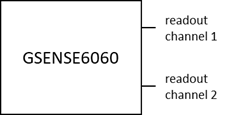STD: standard
HDR: high dynamic range
CMS: correlated multiple sampling
In CMS mode, the reset and pixel output are sampled multiple times and summed up for pixel-related noise suppression.
Readout from sCMOS (Scientific CMOS) sensors used in XIMEA cameras is a bit more complex which is where this simple explanation can help understand the final speed (frames per second) and output:
HDR channel merging description can be found HERE
Sensor readout 2 x 12 bit means one High gain (HG) and one Low gain (LG) channel.
That is how these sensors work.
Transport depends on the output_bit_depth parameter.
It can be set to 8, 10, 12, 16 which means 2x8, 2x10 and so on.
Image formats:
RAW8, RAW16 - data are merged from HG and LG.
RAW8x2, RAW16x2 - RAW data from the sensor. Both HG and LG data for each pixel are present.
Sensor readout 4 x 10 bit means again High gain and Low gain data, but for Signal image and Reset image each.
Transport depends on output_bit_depth parameter.
It can be set to 8, 10, 12, 16 which means 4x8, 4x10 and so on.
Image formats:
RAW8, RAW16 - data are merged from HG and LG, and both Signal and Reset images.
RAW8x4, RAW16x4 - RAW data from the sensor. Both HG and LG data for a pixel for Signal image and Reset image are present.
To calculate the frame rate and other parameters you can use this helpful TOOL.
Fill inputs (the orange values) and see the expected results.
Each input is connected to a xiApi parameter - e.g. Transport bit depth field is XI_PRM_OUTPUT_DATA_BIT_DEPTH xiapi parameter
Because of the processes mentioned above, in this case, if you change the Transport Bit Depth from 8 to 10 the Frame rate is still the same for example.
Note: 1300 MB limit was introduced into the Calculator because not all computer configurations were able to support higher speed, but now certain PCs could reach stable 1750 MB.
Gpixel sensors (GSENSE400, GSENSE2020, GSENSE5130 and others) offer 3 operation modes:
HDR, STD and CMS
These sensors support 12-bit readout modes and have 2 different on-pixel gain modes:
High gain (HG), optimized for low readout noise.
Low gain (LG), optimized for high full well capacity.

Merger:
O16 = (DL12 * k + DH12 * (1 – k) * g) * 16 = DL12 * k * 16 + DH12 * (1 – k) * g * 16
there:
O16 – 16bit output signal.
DL12 - 12bit data of LG channel.
DH12 - 12bit data of HG channel.
k = DH12 / 4095.
g = gL / gH.
gL – gain of LG channel.
gH – gain of HG channel.
In HDR mode the analog gains are fixed (gL and gH) and can’t be changed by API.

SUM:
O16 = (DL12 + DH12) * 8 = D13 * 8
gL = gH
Both ADCs readout the same pixel at one time.

Packer:
O12 (pixel 0) = DL12 (pixel 0, row 0)
O12 (pixel 1) = DH12 (pixel 0, row 1)
O12 (pixel 2) = DL12 (pixel 1, row 0)
O12 (pixel 3) = DH12 (pixel 1, row 1)
gL = gH
In CMS and STD modes gain on both channels can be changed in API.
Useful documents:
sCMOS camera modes
How to set different readout modes for MX377
The MX377 models use two different types of sensors:
GSENSE6060: frontside illuminated (FSI) scientific CMOS (sCMOS)
GSENSE6060BSI: backside illuminated (BSI) sCMOS
Both types of sensors (FSI and BSI) allow 12- and 14-bit readout modes.
Please note that sCMOS sensors support 2 different on-pixel gain modes:
High gain (HG), optimized for low readout noise.
Low gain (LG), optimized for high full well capacity.
GSENSE6060 and GSENSE6060BSI are rolling shutter sensors.
The GSENSE6060 sensor has two readout channels (gain channels 1 and 2 in the figure below) which are used differently depending on the operation mode:

The MX377 supports different modes:
Standard (STD), 12- and 14-bit, high-gain or low-gain
2x correlated Multiple Sampling (2-CMS), 12- and 14-bit, high-gain or low-gain
4x correlated Multiple Sampling (4-CMS), 12- and 14-bit, high-gain or low-gain
HDR, 12-bit, high- and low-gain
HDR, 12-bit, high-gain or low-gain
HDR / 2-CMS, 12-bit high- and low-gain
Here you can see a table with the preliminary image quality parameters for different modes:
| Modes | gain [dB] | dark noise [e] | FWC [ke] | Dyn.Range [dB] | ||||
| HDR_LG | -- | 3.4 | 101 | 89.45 | ||||
| CMS2_LG | 0 | 18.3 | 98 | 74.57 | ||||
| CMS2_HG | 21.4 | 2.2 | 3 | 63.15 | ||||
| STD | 0 | 26 | 105 | 72 |
Full HDR mode is also planned which will help the camera to achieve lower dark noise (as compared to HDR_LG mode) while leaving the FWC same.